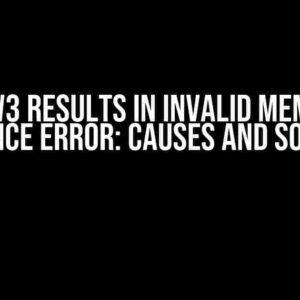Are you tired of encountering the frustrating “There is no argument given that corresponds to the required parameter” error in your code? Do you find yourself scratching your head, wondering what’s causing this issue and how to fix it? Fear not, dear developer, for this article is here to help you troubleshoot and resolve this pesky problem once and for all!
What does the error mean?
The “There is no argument given that corresponds to the required parameter” error typically occurs when your code is expecting a specific argument or parameter to be passed, but it’s not receiving one. This can happen in various programming languages, including Python, Java, C#, and more. In this article, we’ll focus on the Python implementation, but the concepts and solutions can be applied to other languages as well.
Causes of the error
There are several reasons why you might encounter this error. Here are some common causes:
- Function or method signature mismatch
- Incorrect argument passing
- Typos in function or variable names
- Missing or optional arguments
- Incorrect data types
Step-by-Step Troubleshooting Guide
Let’s dive into the step-by-step process to identify and fix the “There is no argument given that corresponds to the required parameter” error.
Step 1: Review the Function Signature
Take a closer look at the function or method signature that’s throwing the error. Check if the expected arguments match the ones you’re passing. Make sure you’re not missing any required arguments or passing extra unnecessary ones.
def my_function(required_arg1, required_arg2, optional_arg=None):
# function implementation
In this example, the function expects two required arguments (`required_arg1` and `required_arg2`) and one optional argument (`optional_arg`). Ensure you’re passing the correct number of arguments when calling the function.
Step 2: Check Argument Passing
Verify how you’re passing arguments to the function. Are you using the correct syntax? Are you passing arguments by position or by keyword?
my_function('value1', 'value2') # passing by position
my_function(required_arg1='value1', required_arg2='value2') # passing by keyword
Make sure you’re passing the correct number and type of arguments, and that you’re using the correct syntax.
Step 3: Look for Typos
Typos can be sneaky! Double-check that you’ve spelled the function and variable names correctly. A single mistyped character can lead to this error.
my_fuction('value1', 'value2') # typo in function name
my_function(required_arg1='value1', requred_arg2='value2') # typo in variable name
Carefully review your code for any typos or spelling mistakes.
Step 4: Check for Missing or Optional Arguments
Some functions or methods have optional arguments that can be omitted. Ensure you’re passing all required arguments and that you’re not missing any optional ones.
def my_function(required_arg1, required_arg2, optional_arg=None):
# function implementation
my_function('value1', 'value2') # missing optional_arg
my_function('value1', 'value2', 'optional_value') # passing optional_arg
Verify that you’re passing all required arguments and that you’re not skipping any optional ones.
Step 5: Inspect Data Types
Another common cause of this error is incorrect data types. Ensure that you’re passing the correct data type for each argument.
def my_function(required_arg1: str, required_arg2: int):
# function implementation
my_function('value1', 'value2') # passing string instead of int
my_function('value1', 2) # correct data types
Verify that you’re passing the correct data type for each argument, as specified in the function signature.
Common Scenarios and Solutions
Here are some common scenarios where you might encounter the “There is no argument given that corresponds to the required parameter” error, along with their solutions:
| Scenario | Error | Solution |
|---|---|---|
| Missing argument | my_function(‘value1’) | Pass the required argument: my_function(‘value1’, ‘value2’) |
| Typo in function name | my_fuction(‘value1’, ‘value2’) | Correct the typo: my_function(‘value1’, ‘value2’) |
| Incorrect data type | my_function(‘value1’, ‘value2’) | Pass the correct data type: my_function(‘value1’, 2) |
| Optional argument not passed | my_function(‘value1’, ‘value2’) | Pass the optional argument: my_function(‘value1’, ‘value2’, ‘optional_value’) |
Conclusion
The “There is no argument given that corresponds to the required parameter” error can be frustrating, but it’s often a simple mistake that can be resolved with a bit of debugging and attention to detail. By following the steps outlined in this article, you’ll be able to identify and fix the error, ensuring your code runs smoothly and efficiently.
Remember to review your function signatures, check argument passing, look for typos, verify optional arguments, and inspect data types. With these techniques, you’ll be well-equipped to tackle this error and get back to coding with confidence!
Happy coding!
Frequently Asked Question
Having trouble with the “‘There is no argument given that corresponds to the required parameter'” error? You’re not alone!
What does “‘There is no argument given that corresponds to the required parameter'” mean?
This error message is telling you that one of the required parameters in your code is missing an argument. Think of it like trying to make a recipe without a crucial ingredient – the code just can’t function without it!
How do I identify the missing parameter?
Take a closer look at the error message – it usually highlights the specific parameter that’s causing the issue. If not, review your code and double-check that you’ve provided all the necessary arguments for the function or method you’re using.
What are some common causes of this error?
Typical culprits include typos in parameter names, missing or incorrect data types, and incorrect function or method calls. Make sure to proofread your code carefully and check the documentation for any APIs or libraries you’re using.
How do I fix the “‘There is no argument given that corresponds to the required parameter'” error?
Once you’ve identified the missing parameter, simply add the required argument to your code. If you’re still stuck, try breaking down the problem into smaller parts or seeking help from a coding community or online resource.
Can I avoid this error in the future?
Absolutely! By following best practices like code reviews, testing, and using linters or code analyzers, you can catch potential issues before they become errors. Additionally, take the time to thoroughly understand the APIs and libraries you’re working with to avoid misunderstandings.


